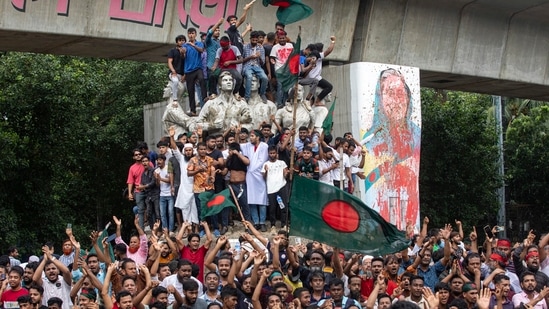Bangladesh protesters storming PM’s house draws parallels to Sri Lankan protest in 2022
Posted on August 5th, 2024
Courtesy The Hindustan Times
Despite the nationwide curfew, protesters began a ‘Long March to Dhaka’ demanding Prime Minister’s resignation, while Hasina labeled the protests as sabotage.
As Bangladesh faces political turmoil due to student protests demanding the abolition of quotas in civil service jobs and with Sheikh Hasina having resigned as prime minister and fled the country, similar scenes unfolded in Sri Lanka nearly two years ago when President Gotabaya Rajapaksa left the country on July 13, 2022.

Despite a nationwide curfew imposed today, protesters initiated a ‘Long March to Dhaka,’ demanding the resignation of Prime Minister Hasina. However, in response, Hasina labeled the demonstrations as sabotage and cut off mobile internet following which the military enforced an indefinite curfew.
Massive discounts on Laptops, TVs, Home Appliances, and Gadgets during this season’s biggest sale – Amazon Freedom Festival 2024! Click Here to Shop now and save big!
Protesters stormed her official residence on Monday afternoon, Channel 24 reported. TV images showed hundreds of people ransacking the building and taking away chicken, fish and vegetables.
Nearly 300 people have been killed in the violent protests against Hasina government’s controversial quota system that meant 30 percent reservation in government jobs for relatives of veterans who fought in Bangladesh’s War of Independence in 1971.
Hasina was elected for a record fourth consecutive term and fifth overall term in the 12th general election held in January amid a boycott by the main opposition party Bangladesh Nationalist Party (BNP) of former premier Khaleda Zia and its allies.
What happened in Sri Lanka in 2022?
In 2022, Sri Lanka saw similar protests starting in March against the government, criticised for its poor economic management leading to high inflation frequent power outages, and shortages of fuel domestic gas and essential goods. The protesters were demanding the resignation of President Gotabaya Rajapaksa.
Following the uprising, all 26 members of the second Gotabaya Rajapaksa cabinet resigned on April 3 except for Prime Minister Mahinda Rajapaksa. Chief government whip Johnston Fernando said that President Gotabaya Rajapaksa would continue with his position under any circumstances.
However, on July 13, thousands of protesters breached Gotabaya Rajapaksa’s official residence in Colombo. Demonstrators from across the nation converged on the city, demanding his resignation after months of unrest over the government’s handling of the economic crisis.
Watch: Sri Lankan protesters storm President’s house, explore kitchen | Video
Footage captured demonstrators swimming in Rajapaksa’s pool and crowding into the President’s House gym. They used the exercise machines, including weights and treadmills typically reserved for the President.
In the lush green gardens, groups gathered with snacks and were sipping tea.
Police fired shots into the air and deployed tear gas in an attempt to deter the angry crowds from overtaking the residence, but were unable to prevent some protesters from entering. Rajapaksa stayed in exile in Singapore before relocating to Thailand in August.